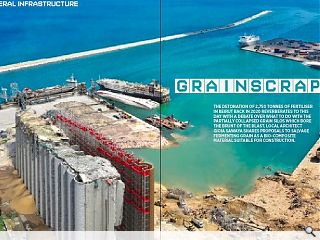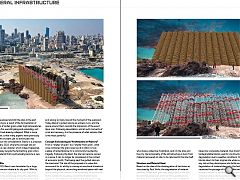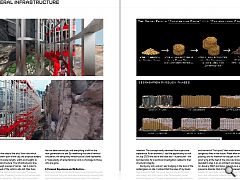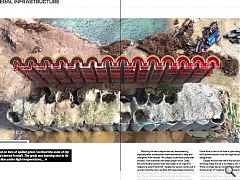Ephemeral Architecture: Grainscraper
27 Oct 2022
The detonation of 2,750 tonnes of fertiliser in Beirut back in 2020 reverberates to this day with a debate over what to do with the partially collapsed grain silos which bore the brunt of the blast. Local architect Gioia Sawaya shares proposals to salvage fermenting grain as a bio-composite material suitable for construction.
Several days have passed and still the silos at the port of Beirut are burning as a result of the fermentation of thousands of tons of spilled grain under high temperatures. Until recently, the fire was still going and extending, and the Northern part had already collapsed. What is more intriguing, however, is that many experts have previously warned against this incident; yet no action plan was implemented or put into consideration. Below is a proposal designed in January 2022, where the concept was all about preventing a new disaster which indeed happened, and how to positively recycle the fermenting grain into a bio-composite material that could actually become a new building material.
Presentation of Site
On August 4th 2020, Beirut was devastated by a huge explosion of ammonium nitrate at its city port. With its notable scale and robust typology, the silos, standing meters away from the warehouse where the detonation initiated, absorbed some of the shockwaves of the blast thus reducing the damage on the Western side of Beirut, and saving so many lives at the moment of the explosion. Today, Beirut’s gutted silos lie as witness ruins, and the space around them records the impression of the event like a scar. Following devastation, and at such moments of crisis and recovery, it is the presence of what remains that is the most powerful.
Concept: Announcing an “Architecture of Memory”
From a “shelter of grain” to a “shelter from grain”, what once contained the grain reserves of a nation is now a place of remembrance for a community touched by tragedy. Following the blast, the site has become sacred in a sense. It can no longer be considered in the context of economic profit. That being said, the gutted silos are the memorial. The role of the proposal is to value this monument for its ability to convey an emotional dimension beyond the physical, reconciling emotional space with real space through the creation of an ephemeral infrastructure that is constantly receding, constantly threatening to evanesce. By redefining the relationship between (1) the silos and the site of the blast, (2) the silos and the Beirutis who share a collective frustration, and (3) the silos and the city, the temporality of the infrastructure is born from material recovered on-site, to be returned to the site itself.
Structure and Material Used
Based on the idea of the disintegration of territories as discussed by Paul Virilio, the degradation of material elements shows how grain was always part of the silos’ life and should be kept, and how this superstructure was able to survive time. The spilled grain is therefore to be removed, pressed and manufactured into a grain-based bio-composite material, thus transformed into biodegradable blocks used for construction. After degradation due to weather conditions, these organic blocks return to their original site while no longer posing any risk as they decompose into fertile soil. Through the degradation of material elements, the fading facade visualizes the passage of time and the inevitability of its transient nature. In addition, the main structure of the proposal utilizes the recycling of steel, made from the affected warehouses at the port, to be constructed and further dismantled.
Circulation
To commemorate the idea of the silos’ front row which protected the Western part of the city, the proposal adopts similar metrics in its scale (length, width, and height) as those of the original structure. The infrastructure’s lane is articulated through a series of ramps - red in color to symbolize the blood of the victims who lost their lives during the blast. The path is continuous and U-shaped, giving the impression of walking inside the cylindrical walls of the original grain elevators. The silos and surrounding landscape remain untouched, as to remind that justice has not been served yet, and everything is left for the next generations to see. By redefining the role of vertical circulation, the temporary infrastructure’s lane represents a “topography of remembrance” and is a homage to those who are gone.
A Personal Experience and Reflection…
Many alternative architectural plans to reconstruct the port and refurbish the grain silos were presented by several local and international architects and engineers. My proposal was more of a solution to a problem rather than a design intention. The concept really stemmed from a personal experience. As an architect, I had the opportunity to visit (in July 2021) the site of the blast and - in particular - the bombed silos for a technical investigation related to their structural integrity.
During my visit, and as I was trudging in the tons of the spilled grain on-site, I noticed that the soles of my boots had started to melt. The grain was burning and smoke was rising from them due to their fermentation under high temperatures. Thermal measurements were made by experts and engineers at the spot. Results were concerning and warned of “hot spots” that would eventually lead to dangerous fires in the future. Week after week, time was passing, and no intention to fully get rid of the spilled grain lying at the feet of the silos was shown. This is when I decided to step in as an architect and design this proposal (in January 2022) pro bono, not only as a wake-up call to prevent a disaster that of course happened, but also as a solution to positively remove and recycle the rotten grain into a bio-composite material that, similar to mycelium mushroom, could become one day a new organic building material used in construction.
Watching the silos collapse was very heartbreaking, especially after knowing that viable alternatives to keep and strengthen them existed. The collapse could have totally been avoided, if the authorities had taken proper action. Sadly, this unfortunate scenario boils down again to an inept and neglecting government that - despite the serious voicing out of concerns and the many red flags that were raised concerning the potential future fires - did not show any intention of placing any effective efforts to avoid this disaster, and to properly maintain the structure as a monument for collective memory.
Following the fire and the Northern section’s total collapse, I think what is next to be done is quite straightforward: the Southern section must be fought for, protected, and safeguarded.
Despite the fact that half of the silos building is no longer standing, today, the silo is no longer a silo. It is a memory. While no longer being a carrier of the nation’s grain, it is a very strong carrier of “meaning”, and I believe that what remains of it is the last hope of coming to terms with justice - which unfortunately hasn’t been served yet - and of dealing with a collective frustration and grief that is constantly being crushed and repressed.
|
|






